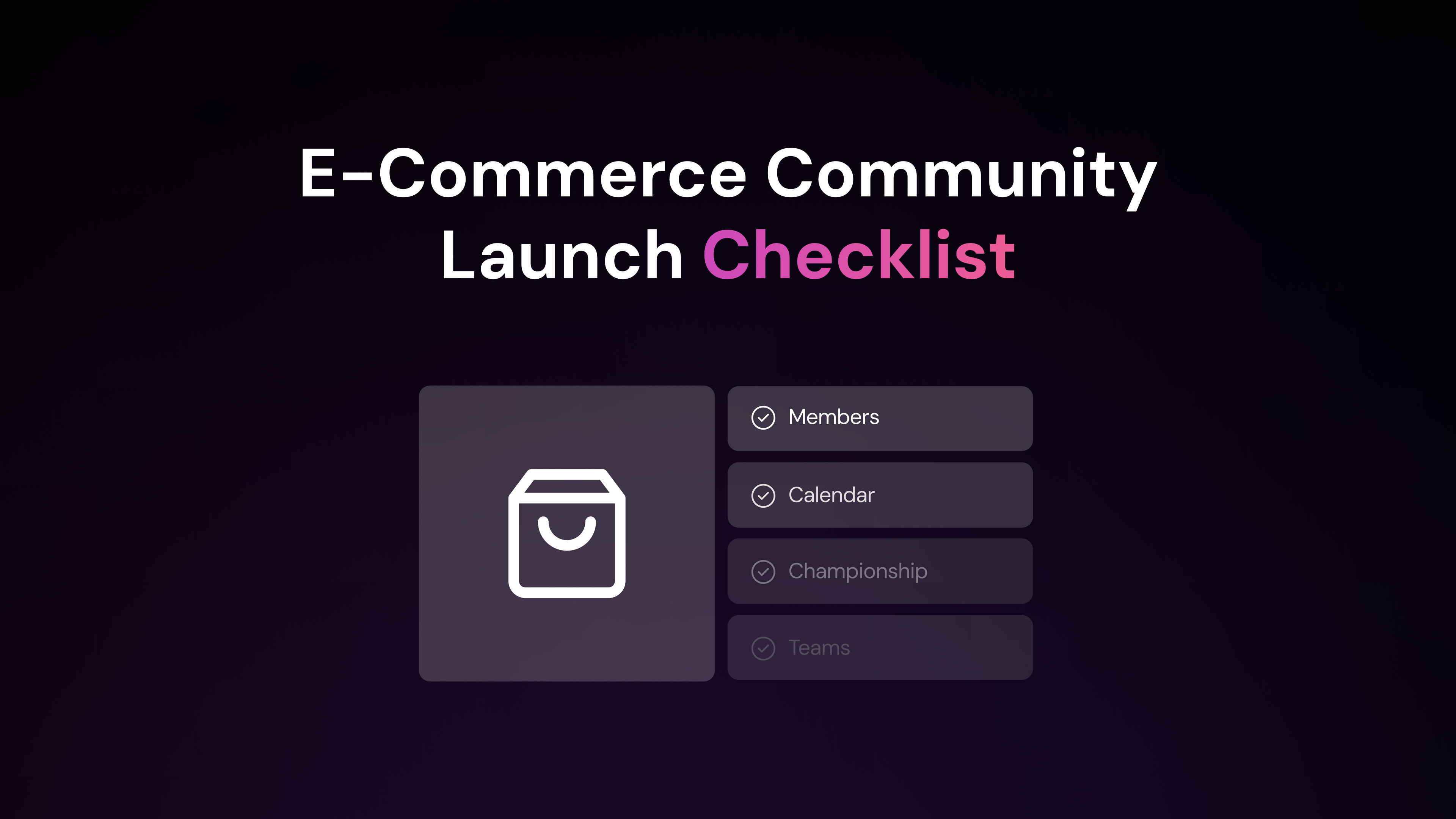Community-driven e-commerce is all about building a brand community for your e-commerce business, which can feel like a big task, but the rewards are worth it. When you create a space where your customers can connect with each other and your brand, you build more than just a customer base—you build loyalty and trust.
Think about it: a community where your customers share their experiences, give feedback and engage with your brand regularly. This kind of interaction can transform your business in ways you might not have imagined.
Let’s dive into the specific benefits of building a brand community for your e-commerce business.
Benefits of Building a Brand Community
Creating a brand community fosters a sense of belonging among your customers.
Increased Customer Loyalty
When people feel like they are part of a group, they are more likely to stick around. This loyalty translates into repeat purchases and long-term engagement. Customers who feel connected to your brand are less likely to switch to competitors, even if they offer similar products. They become advocates for your brand, sharing their positive experiences with others and bringing in new customers through word-of-mouth.
Enhanced Brand Awareness
A vibrant brand community can significantly boost your brand’s visibility. Members of your community will naturally talk about your brand on social media, forums, and other platforms. This organic promotion can reach potential customers who might not have discovered your brand otherwise. As your community grows, so does your brand’s presence in the market. This increased awareness can lead to higher traffic to your website and more opportunities for conversions.
Valuable Customer Insights
Your brand community is a goldmine of information. By engaging with it, you can gain insights into what your customers like, dislike, and want from your products. This feedback is invaluable for making informed business decisions. Whether you’re tweaking a product feature or launching a new product line, the insights from your community can guide your strategy. Regular interaction with your community helps you stay attuned to their needs and preferences, keeping your brand relevant and responsive.
Reduced Marketing Costs
Building a brand community can also help you save on marketing expenses. When your community members share their positive experiences and recommend your products, they are doing the marketing for you. This kind of organic marketing is often more effective than traditional advertising and can significantly reduce your overall marketing costs. Plus, a loyal community means you spend less on customer acquisition and more on retention and engagement.

Key Elements of a Successful Community-Driven E-Commerce Strategy
Building a brand community can seem daunting, but having a clear strategy makes it much more manageable.
Defining Clear Goals
Start by setting clear, achievable goals for your brand community. Determine what you want to accomplish, whether it’s increasing customer loyalty, boosting brand awareness, or gathering valuable customer insights. Clear goals help you stay focused and measure success. For example, if your goal is to increase engagement, track metrics like the number of active members, posts, and comments. Explore customer engagement strategies to set the right goals for your brand community. If you’re aiming to boost sales, monitor conversion rates and customer lifetime value. Having specific goals allows you to tailor your strategies and resources effectively.
Identifying Target Audience
Knowing your target audience is critical to building a successful brand community. Identify who your ideal community members are based on demographics, interests, and behaviors. Use data from your existing customer base to create detailed personas. Understanding your audience helps you create content and interactions that resonate with them. For instance, if your audience consists of young professionals, focus on creating content that addresses their lifestyles and challenges. Tailoring your approach to your audience’s needs and preferences ensures higher engagement and satisfaction.
Choosing the Right Platforms
Selecting the right platform for your brand community is crucial. Consider where your target audience spends their time online. Popular options include social media platforms like Facebook, Instagram, and LinkedIn, as well as dedicated community platforms like Discord or Slack. Each platform has its strengths and weaknesses, so choose one that aligns with your goals and audience preferences. For example, if you want to foster in-depth discussions, a forum or dedicated community platform might be best. If you aim for quick interactions and broad reach, social media platforms are ideal. Building online communities can start with choosing the right platform.
Encouraging User-Generated Content
User-generated content (UGC) adds authenticity and trust to your brand community. Encourage members to share their experiences, reviews, and creative content. UGC not only boosts engagement but also provides valuable insights into how customers use and perceive your products. Create opportunities for members to contribute, such as photo contests, hashtag campaigns, and discussion threads. Recognize and reward active contributors to motivate others to participate. Highlighting UGC on your website and social media channels can also attract new members and build credibility.
Providing Value to Members
Your brand community should offer tangible value to its members. This value can come in various forms, such as exclusive content, special offers, and access to expert advice. Providing value keeps members engaged and encourages them to stay active in the community. For example, offer members early access to new products, discounts, or free resources like e-books and webinars. Regularly update the community with fresh content and opportunities to keep it dynamic and interesting. When members feel they are gaining something valuable, they are more likely to remain loyal and engaged.
Engaging with the Community
Active engagement is vital for a thriving brand community. Regularly interact with members through comments, messages, and live events. Show appreciation for their contributions and address their concerns promptly. Engagement fosters a sense of belonging and trust, making members feel valued. Host Q&A sessions, polls, and discussions to keep the conversation going. Encourage members to interact with each other as well, creating a network of support and shared interests. Implement community flywheel strategies to ensure continuous growth and engagement. Consistent engagement helps build strong relationships and a vibrant community atmosphere.
Measuring and Analyzing Performance
Track the performance of your brand community to understand what’s working and what needs improvement. Effective tracking audience engagement strategies can optimize your community’s performance. Use analytics tools to monitor key metrics such as engagement rates, member growth, and content performance. Analyze this data to identify trends and make data-driven decisions. For example, if you notice a drop in engagement, investigate the cause and adjust your strategy accordingly. Regularly review your goals and measure progress to ensure your community efforts align with your overall business objectives. Continuous analysis helps you refine your approach and achieve better results over time.
How to Create a Thriving Community-Driven E-commerce Brand
Establishing a strong brand identity is the first step to creating a thriving e-commerce brand community. Another is staying updated with the latest customer engagement trends to keep your strategies fresh and effective.
Establish a Strong Brand Identity
Your brand identity serves as the foundation of your community. It encompasses your brand’s values, mission, and visual elements. Consistency in these areas helps your audience recognize and connect with your brand. Ensure your messaging, tone, and visuals align across all platforms. This creates a cohesive experience that resonates with your community members. A strong brand identity fosters trust and loyalty, making it easier for members to engage and participate.
Leverage Social Media Platforms
Social media platforms are powerful tools for building and nurturing your brand community. Identify where your target audience spends their time and focus your efforts on those platforms. Use features like groups, live videos, and stories to interact with your audience in real-time. Encourage discussions, share user-generated content, and provide timely updates. Social media allows for direct communication, making it easier to build relationships and keep your community engaged.
Offer Exclusive Benefits and Rewards
Incentivize your community members by offering exclusive benefits and rewards. This can include early access to new products, special discounts, or members-only content. These perks make your community feel valued and appreciated. Implement a loyalty program that rewards members for their participation and purchases. Recognize and celebrate active members to encourage ongoing engagement. Exclusive benefits and rewards create a sense of belonging and motivate members to stay involved.
Host Events and Challenges
Organize events and challenges to keep your community active and engaged. Virtual events like webinars, Q&A sessions, and live demos provide opportunities for real-time interaction. Challenges, such as photo contests or DIY projects, encourage members to participate and share their experiences. These activities not only boost engagement but also generate user-generated content that can be shared across your platforms. Events and challenges create excitement and foster a sense of community among members. Learn from successful online communities to inspire your own events and challenges.
Collaborate with Influencers and Experts
Partnering with influencers and experts can significantly enhance your brand community. Influencers bring credibility and reach, attracting new members to your community. Choose influencers who align with your brand values and have a genuine connection with your target audience. Collaborations can include guest blog posts, social media takeovers, or co-hosted events. Experts can provide valuable insights and content, adding depth to your community discussions. Collaborations with influencers and experts help expand your community and provide valuable content for your members.
Best Practices for Managing a Community-Driven E-Commerce Brand
Managing a brand community requires dedication and strategic planning, but it’s essential for long-term success.
Appoint Dedicated Community Managers
Dedicated community managers are key to maintaining an active and engaged community. These individuals should be responsible for overseeing daily interactions, fostering a positive environment, and addressing any issues that arise. Community managers act as the bridge between your brand and its members, ensuring that communication flows smoothly. They should be skilled in social media management, customer service, and conflict resolution. By having dedicated personnel, you ensure that your community receives the attention and care it needs to thrive.
Develop a Content Calendar
A content calendar helps you plan and organize your community activities and posts. This tool ensures that you consistently provide fresh and engaging content to your members. Schedule a mix of content types, including blog posts, videos, polls, and user-generated content. A well-structured calendar allows you to align your content with key dates, product launches, and promotional events. It also helps you maintain a steady flow of communication, keeping your community engaged and informed. Regular updates and diverse content keep the community vibrant and active.
Respond to Feedback and Inquiries Promptly
Timely responses to feedback and inquiries show your community that you value their input and are attentive to their needs. Prompt replies help build trust and strengthen relationships with your members. Make it a priority to address questions, concerns, and suggestions as quickly as possible. This practice not only enhances member satisfaction but also provides valuable insights into areas where your brand can improve. Active engagement demonstrates your commitment to the community and encourages ongoing participation.
Moderate Discussions and Enforce Guidelines
Effective moderation is crucial to maintaining a respectful and positive community environment. Set clear guidelines for behavior and interaction and enforce them consistently. Community managers should monitor discussions to ensure that members adhere to these rules. Address any violations promptly and fairly to prevent issues from escalating. By maintaining a safe and welcoming space, you encourage more members to participate and contribute. Consistent moderation helps uphold the integrity of your community and fosters a sense of trust among members.
Continuously Improve Based on Insights
Regularly analyze your community’s performance to identify areas for improvement. Use analytics tools to track engagement metrics, member activity, and content performance. Gather feedback from your community members to better understand their needs and preferences. Use this data to refine your strategies and introduce new initiatives that enhance the community experience. Continuous improvement ensures that your community remains relevant and valuable to its members. By staying responsive to insights, you can adapt to changing dynamics and keep your community thriving.
Take the Next Step with Arena
Building a community-driven e-commerce brand requires the right tools and strategies. Arena offers everything you need to engage your audience, foster loyalty, and gather valuable insights. Our AI-powered solutions, including real-time group chat, content streams, and community-building tools, are designed to help you create a thriving e-commerce brand community.
Ready to transform your e-commerce business and see tangible results? Visit our pricing page to explore our plans and find the perfect fit for your needs. Sign up now and start building a community that drives growth and engagement.



